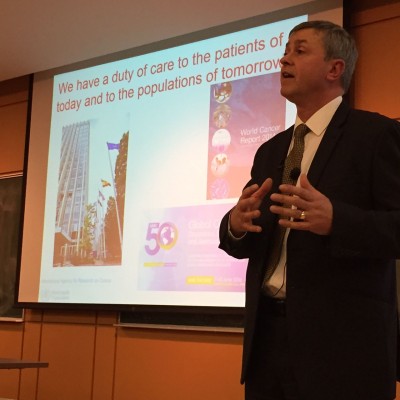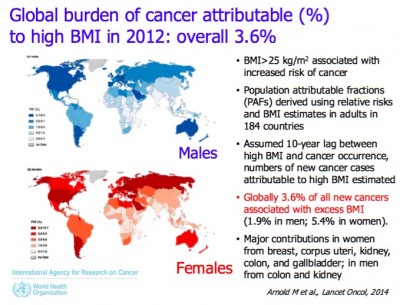 By Josee Beaudry, Department of Psychology, Carleton University
By Josee Beaudry, Department of Psychology, Carleton University
Chances are that most people know someone who has been affected by cancer in some way or form. In his November 6 talk at Carleton University, Dr. Christopher Wild, Director of the International Agency for Research on Cancer (IARC), shed light on this global issue. An agency of the World Health Organization, IARC collects data on cancers, provides quantitative assessments of risks and evaluates preventative measures.
It is estimated that approximately 32.5 million people are living with cancer. Analysis of data collected by IARC shows that 1 in 8 men and 1 in 12 women will die from cancer. Some areas in the world have higher rates of death due to cancer, such as China (26.9%), Europe (21.4%) and East/ Central Asia (17.3%). An emerging trend is increased cancer rates in developing countries. Some 57% of all cancer cases and 65% of cancer deaths come from l countries lacking the capacity to diagnose and treat advanced cancers.

Wild argued that cancer prevention requires attention to how cancer rates and correlates differ from place to place. There are different factors associated with cancer rates and deaths depending on where people live. There are also differences within populations. For example, Wild cited newly-published research demonstrating that incidence rates of breast cancer were higher among non-Indigenous women in many regions (roughly equal rates in Canada), but that cervical cancer was more common among Indigenous women, including in Canada.
Preventing cancer is important for many reasons. But for those who are most influenced by the financial implications, productivity loss due to cancer is a huge burden on the economy. The IARC studied productivity loss in 30 European countries and estimated a loss of €75 billion ($107 billion).
Cancer is a common disease in today’s world, but it is also a complex disease that differs from place to place, person to person, and type of cancer. Its impact is not only at the individual level but also globally. Wild emphasized that it has become such a vast and complex issue and that we cannot simply treat our way out of the problem.
What we need to know and how to take action
Wild went on to say that if we cannot treat our way out of the cancer problem then we must adopt a balanced and integrated approach to prevention, early detection, and treatment. To improve prevention the world needs to know more about the risk factors associated with cancer. A few of these risks include tobacco, alcohol, occupation, infections, diet and obesity. IARC has evaluated multiple agents and their possible carcinogenic effects. For example, processed meat, air pollution, and diesel exhaust. By discovering which factors have carcinogenic effects we can limit or screen for exposure to harmful substances.
 Primary cancer interventions would apply the knowledge we already have to avoid potentially harmful habits. For example, IARC estimates that worldwide, 3.6% of all recent cancer cases are due to obesity. Interventions to improve diet and exercise can be deployed to reduce this risk. In the end, the majority of cancers in the fully developed market economies are associated with diet and personal choices (e.g. smoking) and some viruses for which vaccines exist suggesting that they are, in fact, preventable. We need to apply what we know and take action.
Primary cancer interventions would apply the knowledge we already have to avoid potentially harmful habits. For example, IARC estimates that worldwide, 3.6% of all recent cancer cases are due to obesity. Interventions to improve diet and exercise can be deployed to reduce this risk. In the end, the majority of cancers in the fully developed market economies are associated with diet and personal choices (e.g. smoking) and some viruses for which vaccines exist suggesting that they are, in fact, preventable. We need to apply what we know and take action.
Secondary methods of prevention include screening for early detection, mammography, cancer awareness, breast examinations, and colonoscopies. Cancer prevention may be highly effective; it just takes a lot of time and effort at both the individual, systems, and global level.
Research into the incidence, distribution and control of cancer is still ongoing, and is most effective when bringing together information from multiple disciplinary perspectives. For example, by identifying specific risk factors, such as stress or diet, we may be able to isolate biological or molecular changes or markers of exposure, which in turn could lead to controlled interventions that contribute to development of personalized treatment.
The cancer problem is complex in the way it manifests differently worldwide. By looking at the causes within populations we can identify the risk factors and work on preventative techniques. But we can also learn by making comparisons across regions globally. To relieve the cancer burden we must combine prevention and treatment efforts, adopt interdisciplinary approaches that guide research directions, and work globally toward diminishing incidence and mortality rates associated with cancer.
On November 6, Dr. Christopher Wild delivered a public lecture on the Global Cancer Burden: Necessity is the Mother of Prevention. If you missed the lecture, you can watch it on youtube.